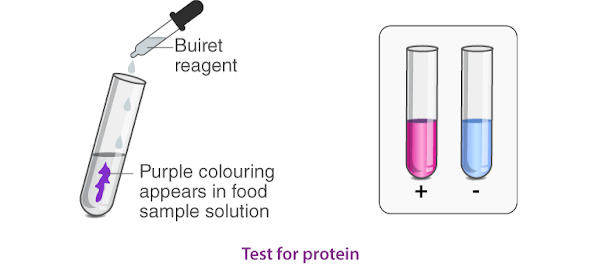Class 6 Science Notes
Chapter 2 Components of Food
What are Nutrients?
→ The food that we eat consists of different nutrients or components.
→ The components of food which are needed by our body is as nutrient.
→ There are six main components present in food:Carbohydrates, fats, proteins, vitamins, minerals and fibers.
→ These components fulfill the different needs of the body.
Carbohydrates
→ Carbohydrates are the compound which is made up of three elements:-Carbon, Hydrogen and Oxygen
→ Carbohydrate provides energy to our body, which keeps it going throughout the day.
→ The main carbohydrates found in our food are in the form of sugars and starch. If food contains starch we can easily test it.
→ The sources of carbohydrates include cereals such as wheat, maize, rice, jawar, bajra, potatoes, bread etc.
→ We can test the presence of carbohydrates by iodine test.
Test for carbohydrates:
Step 1: Take the food item in the test tube and add 2-3 drops of dilute iodine solution to it.
Step 2: After some time if the colour changes to blue-black, it indicates the presence of starch in the food item.
Proteins
→ Proteins are the complex compounds made up of carbon, hydrogen, oxygen, nitrogen and sulphur.
→ The sources of proteins are: cheese, egg, soya bean, pulses, meat etc.
→ Protein is known as body-building food.
Test for proteins:
Step 1: Take food item in the test tube and Add 10 drops of water to it and mix well.
Step 2: Now add 2 drops of copper sulphate and ten drops of caustic soda (sodium hydroxide) solution.
Step 3: Mix it well and keep it undisturbed for some time.
Step 4: After some time you observe the development of violet color in the test tube, it indicates the presence or the proteins.
Fat
→ Fat also provides energy to our body. Fat gives more energy as compared to carbohydrates.
→ Some sources of fat are oil, ghee, egg yolk, milk, butter etc.
Test for fats:
Step 1: Take some food item in a paper and wrap it.
Step 2: Then try to crush it taking care that the paper is not torn.
Step 3: After that take out the food item and allow the paper to be dried for some time.
Step 4: If you can find the oil spots on the paper it indicates the presence of fats in the food item.
Vitamins
→ Vitamins are a group of organic compound which is essential in small amounts for maintaining normal health and development.
→ Vitamins help in protecting our body against diseases. It helps in keeping our eyes, bones, teeth and gums healthy.
→ There are two types of vitamins some are fat soluble and some are water soluble.
→ Vitamins are of different types: - vitamin A, vitamin C, vitamin D, vitamin E, and vitamin K.
→ There are some other vitamins known as vitamin B complex which contain vitamin B1, vitamin B2, vitamin B3, vitamin B5, vitamin B6, vitamin B7, vitamin B9 and vitamin B12.
Minerals
→ Minerals perform important functions such as formation of bones, teeth and blood cell and also maintain the normal heartbeat.
Roughage
→ Roughage is also called dietary fibers.
→ It consist of indigestible plant carbohydrates called cellulose.
→ The source of Roughage is fresh fruits, whole grains and pulses.
Balance diet
→ Our diet should have all the required nutrients in right proportions this should also contain some water and dietary fibers this kind of diet is called as Balanced diet.
→ Balance diet is important for growth and maintenance of good health,
→ It can be very harmful for us to eat too much of fat rich foods and we may end up suffering from a condition called obesity.
Deficiency Diseases
→ Diseases that occur due to lack of nutrients over a long period are called as deficiency diseases.
→ If we do not take a particular nutrient over a long period of time, we suffer from its deficiency.
• Lack of iodine quantity in our body causes Goiter.
• Lack of calcium cause the deficiency bone and tooth decay
• Vitamin A deficiency cause loss of vision
• Vitamin D deficiency cause Rickets
• Lack of iron causes Anemia.

.png)














